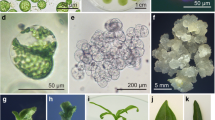Summary
Twelve 2x potato clones of diverse genetic origin were tested for doubling of their chromosome number by placing stem and petiole segments in the regeneration medium (Hermsen et al., 1981). Eleven of the 12 clones yielded doubled plants (2n=4x=48). The percentages of regenerated tetraploid plants varied from 0 to 77% among the genotypes tested. The high rates of successful doubling from many genetically different clones, demonstrates the applicability of this method as a means to convert valuable 2x potato germplasm into the 4x level.
Similar content being viewed by others
References
Ancora, G. & K. S. Ramulu, 1981. Plant regeneration from in vitro cultures of stem internodes in self-incompatible triploidLicopersicon peruvianum Mill. and cytogenetic analysis of regenerated plants.Plant Science Letters 22: 197–204.
Chase, S. S., 1963. Analytic breeding inSolanum tuberosum L. — Scheme utilizing parthenotes and other diploid stocks.Canadian Journal of Genetics and Cytology 5: 359–363.
De, Maine, M. J. & J. A. Fantes, 1983. The results of colchicine treatment of dihaploids and their implications regarding efficiency of chromosome doubling and potato histogeny.Potato Research 26: 289–294.
De, Maine, M. J., L. A. Farrer & M. S. Phillips, 1986. Breeding for quantitative resistance to potato cyst nematode (Globodera pallida) in tetraploid potatoes using diploids and unreduced gametes.Euphytica 35: 1001–1006.
Espinoza, N. O. & J. H. Dodds, 1985. Adventitious shoot formation on cultured potato roots.Plant Science 41: 121–124.
Frandsen, N. O., 1967. Cromosomenverdopplung und Chimaerenbildung nach Colchicinbehandlung haploider Kartoffelsamen.European Potato Journal 10: 1–15.
Hermsen, J. G. Th., M. S. Ramanna, S. Roest & A. S. Bokelmann, 1981. Chromosome doubling through adventitious shoot formation on in vitro cultivated leaf explants from diploid interspecific potato hybrids.Euphytica 30: 239–246.
Hermundstad, S. A. & S. J. Peloquin, 1985. Germplasm enhancement with potato haploids.Journal of Heredity 76: 463–467.
Hougas, R. W. & S. J. Peloquin, 1960. Crossability ofSolanum tuberosum haploids with diploidSolanum species.European Potato Journal 3: 325–330.
Iwanaga, M., 1984. In: Abstracts of Conference Papers of the 9th. Triennial Conference of EAPR. p. 50–51.
Iwanaga, M. & P. Jatala, 1986. Breeding of potato for resistance of root-knot nematodesMeloidogyne incognita: Transfer of resistance from wild diploid species to 4x cultivars.American Potato Journal 63: 437.
Huaman, Z. & R. W. Ross, 1985. Updated listing of potato species names, abbreviations and taxonomic status.American Potato Journal 62: 629–641.
Jacobsen, E., 1977. Doubling dihaploid potato clones via leaf tissue culture.Zeitschrift für Pflanzenzüchtung 80: 80–82.
Mendiburu, A. O., S. J. Peloquin & D. W. M. Mok, 1974. Potato breeding with haploids and 2n gametes. In: K. Kasha (Ed.), Haploids in higher plants, p. 249–258.
Mok, D. W. S. & S. J. Peloquin, 1975. The inheritance of three mechanisms of diplandroid (2n pollen) formation in diploid potatoes.Heredity 35: 295–302.
Murashige, T. & F. Skoog, 1962. A revised medium for rapid growth and bio-assay with tobacco tissue culture.Physiologia Plantarum 15: 473–497.
Ross, R. W., L. A. Dionne & R. W. Hougas, 1967. Doubling the chromosome number of selectedSolanum genotypes.European Potato Journal 10: 37–52.
Sonnino, A., 1985. Anther culture and its uses in potato breeding. In: Innovative methods for propagating potatoes, Report of the 28 Planning Conference, Lima, Peru, International Potato Center, p. 319–335.
Tavazza, R. & G. Ancora, 1986. Plant regeneration from mesophyll protoplasts in commerical potato cultivars (Primura, Kennebec, Spunta, Désirée).Plant Cell Report 5: 243–246.
Wenzel, G., O. Schieder, T. Przewozny, S. K. Sopory & G. Melchers, 1979. Comparison of single cell culture derivedSolanum tuberosum L. plants and a model for their application in breeding programs.Theoretical and Applied Genetics 55: 49–55.
Author information
Authors and Affiliations
Rights and permissions
About this article
Cite this article
Sonnino, A., Iwanaga, M. & henostroza, A. Chromosome number doubling of 2x potato lines with diverse genetic background through tissue culture. Potato Res 31, 627–631 (1988). https://doi.org/10.1007/BF02361855
Accepted:
Issue Date:
DOI: https://doi.org/10.1007/BF02361855




